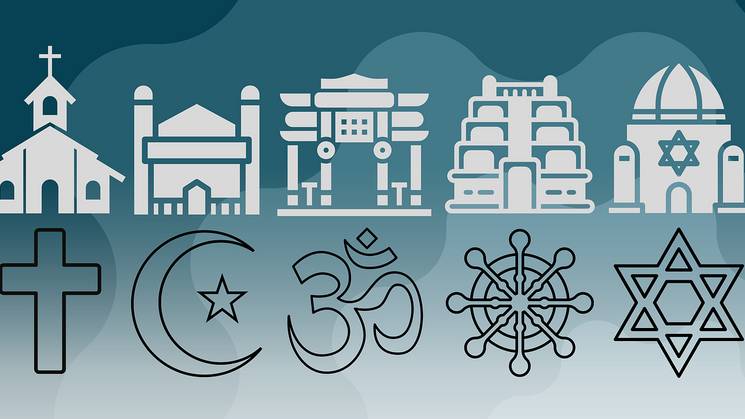Sacred Books

Since the dawn of humanity, writing has been a bridge between the earthly and the divine. Through it, different religious traditions have captured their wisdom, revelations, and principles, granting certain texts a sacred character. These books not only convey doctrines and norms but also serve as an expression of a spiritual quest that transcends centuries and cultures.
In this exhibition, we present the sacred texts of five major religious traditions, each with its own history, significance, and message.


The Bible (Christianity): It is the sacred book of Christianity, composed of the Old Testament and the New Testament. It contains the accounts of creation, the history of the people of Israel, the life and teachings of Jesus, and the mission of his followers. It is a source of faith, inspiration, and guidance for millions of people around the world.
The word Bible comes from the Greek βιβλίον, which means "book." The Old Testament refers to the history of the people of Israel from creation up to the time before the coming of Jesus. It is divided into the Pentateuch (the first five books), the Historical books, the Prophetic books, and the Poetic books. The New Testament consists of 66 books, including the four Gospels (Matthew, Mark, Luke, and John), the Acts of the Apostles, the Letters, and the Book of Revelation.
Since the Bible is a compilation of several books written at different moments in history, there are various versions. The Catholic version includes 73 books—46 in the Old Testament and 27 in the New Testament—while Protestant Bibles usually contain 66 books, omitting seven books from the Old Testament, known as the Deuterocanonical books.

The Torah (Judaism): The Torah comprises the first five books of the Hebrew Bible and forms the foundation of Jewish tradition. It contains the origin story of the people of Israel, as well as the Law revealed by God to Moses on Mount Sinai. As such, it is an essential text for Jewish identity and religious practice.
The Torah includes the books of Genesis, Exodus, Leviticus, Numbers, and Deuteronomy, which speak not only about the origins of the Israelites but also about the creation of the world. The Hebrew word Torah means “teaching,” “instruction,” or “law,” and its contents reflect God's teachings to the people of Israel. The Torah should not be confused with other significant Hebrew texts used in Jewish religious life, such as the Talmud, the Tanakh, or the Mishnah.

The Qur'an (Islam): The Qur'an is the sacred book of Islam, regarded by Muslims as the word of God revealed to the Prophet Muhammad through the Archangel Gabriel. Written in Arabic, the Qur'an contains teachings on faith, morality, justice, and community life.
The Qur'an is composed of 114 chapters, called surahs, which vary in length and are further divided into verses known as ayat. In total, the Qur'an contains 6,236 ayat. Each part of the Qur'an holds specific meaning and purpose in the spiritual and religious life of Muslims. The first surah, Al-Fatiha—also known as “The Opening”—is recited in every cycle of Islamic prayer (salat).

The Bhagavad-gītā (Hinduism): The Bhagavad-gītā is a philosophical and spiritual dialogue that forms part of the Mahabharata, one of the great epics of Hinduism. In it, the god Krishna instructs the warrior Arjuna on duty, devotion, and the path to spiritual liberation.
The name Bhagavad Gita means “The Song of God,” and it is considered the most important sacred text in Hinduism, offering profound philosophical and spiritual teachings. It consists of 700 verses written in Sanskrit, blending concepts from the foundational Hindu scriptures—the Vedas and the Upanishads—into a unique and coherent vision that emphasizes belief in one God and the underlying unity of all existence.
The Tipitaka (Buddhism): The Tipitaka is the collection of the Buddha's teachings and forms the foundation of Theravāda Buddhism. It is divided into three main sections, called pitaka, meaning "basket," in reference to the containers in which palm-leaf manuscripts were stored. For this reason, the canon is traditionally known as the Tripiṭaka ("three baskets"):
Vinaya Pitaka ("Basket of Discipline"): Deals with the rules and the disciplinary life of the sangha (the Buddhist community). Sutta Pitaka ("Basket of Discourses"): Contains sermons and teachings attributed to the Buddha, as well as religious poetry. Abhidhamma Pitaka ("Basket of Higher Knowledge"): Gathers philosophical treatises that elaborate on Buddhist doctrines, especially those concerning the mind and reality.
Although the canon was transcribed about two thousand years ago, its oral origins remain present in Buddhist practice: memorization and recitation continue to be common methods of study and transmission.

Estos textos más que simples libros, son testimonios de fe, tradición y trascendencia. A través de ellos, generaciones han encontrado guía, consuelo y sentido, recordándonos el poder de la palabra escrita para conectar lo humano con lo sagrado.
